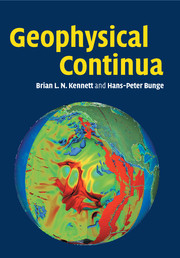Book contents
- Frontmatter
- Contents
- Preface
- 1 Introduction
- PART I CONTINUUM MECHANICS IN GEOPHYSICS
- 2 Description of Deformation
- 3 The Stress-Field Concept
- 4 Constitutive Relations
- 5 Linearised Elasticity and Viscoelasticity
- 6 Continua under Pressure
- 7 Fluid Flow
- 8 Continuum Equations and Boundary Conditions
- PART II EARTH DEFORMATION
- Appendix: Table of Notation
- Bibliography
- Index
4 - Constitutive Relations
from PART I - CONTINUUM MECHANICS IN GEOPHYSICS
Published online by Cambridge University Press: 17 March 2011
- Frontmatter
- Contents
- Preface
- 1 Introduction
- PART I CONTINUUM MECHANICS IN GEOPHYSICS
- 2 Description of Deformation
- 3 The Stress-Field Concept
- 4 Constitutive Relations
- 5 Linearised Elasticity and Viscoelasticity
- 6 Continua under Pressure
- 7 Fluid Flow
- 8 Continuum Equations and Boundary Conditions
- PART II EARTH DEFORMATION
- Appendix: Table of Notation
- Bibliography
- Index
Summary
The balance laws for linear and angular momentum (3.1.2), (3.1.3) do not make any reference to the properties of the body. The full specification of the mechanical and thermal properties of a material requires further information as to the relation between stress and strain, and thus to the relation between the geometry of deformation and the resulting stress field. This information is provided by a constitutive equation which gives a mathematical representation of the functional dependence between stress and strain, designed to provide agreement with the observed behaviour. The behaviour of real materials is both diverse and complex, and so most constitutive equations are designed to capture the most important features of the mechanical behaviour of a material in a particular situation. The mathematical formulation may well be an approximation to the macroscopic response induced by a specific set of atomic scale processes such as, e.g., the movement of dislocations in plastic deformation.
Mathematical and physical models of constitutive relations are most effective when dealing with a single material, since it is difficult to capture the full behaviour of a composite with a single relation. However, although geological materials are composed of an aggregate of minerals, many aspects of the behaviour of rocks can be captured through fairly simple representations with temperature and pressure dependence.
- Type
- Chapter
- Information
- Geophysical ContinuaDeformation in the Earth's Interior, pp. 54 - 70Publisher: Cambridge University PressPrint publication year: 2008



